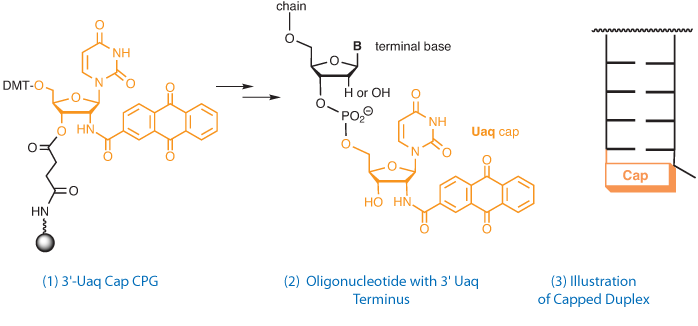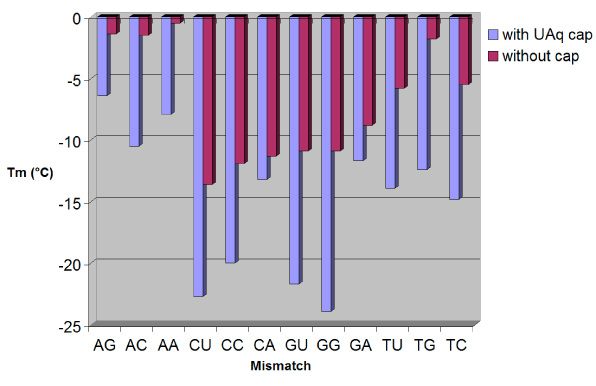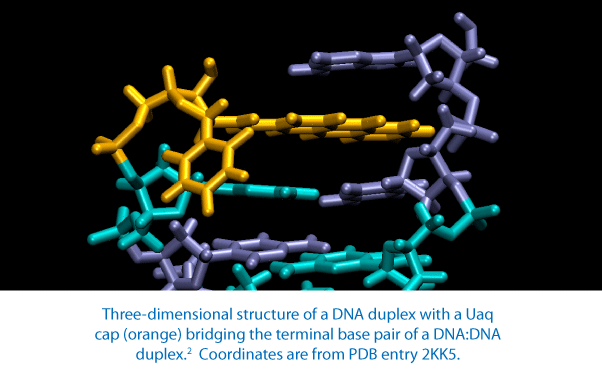Glen Report 21.23: A 3'-Cap for Improved Target Affinity and Specificity
Glen Research is pleased to offer a new controlled pore glass support for the synthesis of oligonucleotides. Syntheses on the 3'-Uaq Cap CPG (1) produce oligonucleotides with a 3’-cap. Caps are covalently appended residues that stabilize double helices by binding to termini.1-3 Caps increase duplex melting points and improve base pairing fidelity by selectively binding to Watson-Crick base pairs. Thus far, only reagents for caps at the 5’-terminus had been available.1,3 The Uaq support now allows for the routine synthesis of oligonucleotides with a cap at the 3’-terminus.
Figure 1 shows the structure of 3'-Uaq Cap CPG (1), the 3’-terminus of an oligonucleotide featuring the Uaq cap (2), and an illustration of a capped duplex (3). Note that the cap does not require a blunt end and will readily bind to target strands with a 5’-overhang.

The 3'-Uaq Cap is also the most effective cap known to date. It increases the melting point (Tm) of DNA:DNA, RNA:RNA, and DNA:RNA hybrid duplexes. For short hybrid duplexes between DNA probes and RNA target strands, the increase is up to 18 °C.2 Further, appending the cap leads to larger DTms between duplexes of perfectly matched sequence and duplexes with a terminal mismatch, thereby improving base pairing fidelity at its terminus. The chart in Figure 2 demonstrates the drop in UV-melting point of the terminal mismatches (stated below each pair of bars) over the perfectly matched control. The sequences are duplexes of a DNA probe with an RNA target strand.2
Figure 2 shows clearly the melting point depressions induced by any of the 12 possible terminal mismatches in octamer DNA:RNA duplexes. In the presence of the 3'-Uaq Cap, even quasi-isostable base combinations, such as G:T wobble and A:A mismatch are discriminated against effectively. Similar data sets are available for DNA:DNA and RNA:RNA duplexes.2 The duplex-stabilizing effect of the 3'-Uaq Cap has also been demonstrated on DNA microarrays.2

As shown in Figure 3, the three-dimensional structure of a DNA:DNA duplex with a Uaq cap at either terminus has been solved.2 This structure confirmed that the anthraquinone residue stacks on the terminal base pairs, and that the uridine residue acts as a linker, while also engaging in molecular interactions in the minor groove. The precise structural information should help those who wish to employ anthraquinone for photophysical or photochemical studies. Anthraquinones are attractive chromophores for electron transport and electrochemical detection.

3'-Uaq Cap CPG, available in popular column formats as well as in bulk, is used in the same way as most other supports. Cleavage, if carried out separately, is done in the same way as for other non-modified nucleoside supports. Deprotection can be carried out using ammonium hydroxide at room temperature (to avoid minor degradation at elevated temperatures), AMA at 65°C or potassium carbonate in methanol, as required for deprotection of the nucleobases.
We would like to take this opportunity to thank Clemens Richert for participating in the preparation of this article and for his enthusiasm for cap structures that enhance DNA binding.
References and Notes:
- 5'-Trimethoxystilbene cap phosphoramidite, Glen Research catalog no. 10-1986, and 5'-pyrene cap phosphoramidite, Glen Research catalog no. 10-1987.
- A. Patra, C. Richert, High fidelity base pairing at the 3'-terminus. J. Amer. Chem. Soc. 2009, 131, 12671-12681.
- C. Ahlborn, K. Siegmund, C. Richert, Isostable DNA. J. Amer. Chem. Soc. 2007, 129, 15218-15232.
Product Information
- Glen Report 21.21: 5-Hydroxymethyl-dC: A New Actor in the Field of Epigenetics
- Glen Report 21.22: Purification of CleanAmp™ DNA Oligonucleotides (DMT-ON)
- Glen Report 21.23: A 3'-Cap for Improved Target Affinity and Specificity
- Glen Report 21.24: Metallobase Nucleic Acid Modification
- Glen Report 21.25: tC and tCo: New Tricyclic Fluorescent Cytidine Analogues with a very Bright Future
- Glen Report 21.26: Non-Aqueous Oxidation for PACE Chemistry
- Glen Report 21.27: New Product - Azobenzene Phosphoramidite for the Introduction of Photo-regulated Functions in DNA
- Glen Report 21.28: Deprotection - Volume 3 - Dye-Containing Oligonucleotides
- Glen Report 21.29: New Products - Glen UnySupport™ Frits
- Glen Report 21.210: New products: Glen-Pak™ DNA Cartridge 3g and DNA 30mg 96-Well Plates
- Glen Report 21.211: Technical Brief – Synthesis of Long Oligonucleotides

